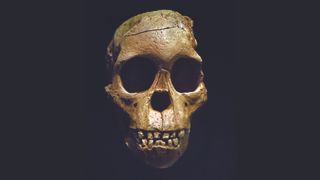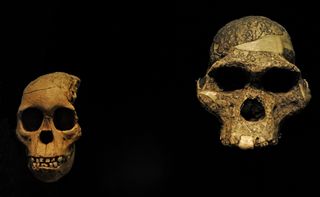
A reproduction of the Taung child skull. The Taung child was an Australopithecus africanus who lived over 2 million years ago.
(Image credit: Peter Horree / Alamy Stock Photo)
One hundred years ago the discovery of a skull in South Africa’s North West province altered our understanding of human evolution. The juvenile skull was dubbed the Taung Child by Raymond Dart, an anatomist at the University of the Witwatersrand, who first described it. In 1924 Dart could not say exactly how old it was, but he announced that it belonged to a new species which he named Australopithecus africanus. It was the first evidence that confirmed British naturalist Charles Darwin’s assertion that apes and humans shared a long-ago common ancestor and that humanity originated from Africa.
Following on from the Taung Child, new discoveries of Australopithecus africanus were made, many at Sterkfontein, about 70km south-west of Pretoria. Sterkfontein is located within the “Cradle of Humankind”, which is a Unesco World Heritage Site.
In the century since the Taung Child was found and described, a great debate has developed about the geological ages of the Australopithecus fossils found at Sterkfontein as well as those from Taung and a third site, Makapansgat.
Much of the controversy is centred on Sterkfontein. Some researchers put the ages of fossils from a particular area (called “Member 4”) at between 3.4 million and 3.7 million years old. Others estimate that those fossils are much younger, dating back to between 2 million and 2.6 million years ago. The differences arise from the dating methods used by the opposing teams. Each has published articles rejecting the other’s methods.
Now the controversy may be a step closer to resolution. With my colleague Sue Dykes (who sadly passed away in 2019), I have used a different approach, applied directly to the fossil teeth of hominins (distant relatives of humankind), to estimate the Sterkfontein Australopithecus fossils’ ages. Our results for Member 4 suggest that the fossils range in age between about 2 million and 3.5 million years. This spans a period wider than previously thought, encompassing the ages estimated by the opposing teams.
Our method also allowed us to date the Taung Child to 2.58 million years ago.
We believe our method is accurate. But there will, no doubt, be other studies using other methods. We are dealing with a question that’s vexed scientists for decades and the quest to definitively say when these ancient members of our family tree existed in South Africa will continue.
Get the world’s most fascinating discoveries delivered straight to your inbox.
One issue that hangs on the answer is the identification of the region from which our genus (Homo) originated: was it in South Africa or east Africa, from an ancestral australopithecine species?
RELATED: 4,500-year-old tomb in France reveals secrets of how ‘European genome’ came to be
Varying methods
One reason it’s been difficult to accurately date the Sterkfontein Australopithecus is that the initial discoveries were made in the course of mining for limestone, using dynamite. That means the context of the fossils was lost.
However, at Sterkfontein and elsewhere in South Africa, fossils have been found of animal species also found in east Africa. Volcanic deposits in east Africa have traces of potassium (K) and argon (Ar) which allow for accurate K/Ar radiometric dating.

A comparison of the Taung Child skull (left) next to another Australopithecus africanus skull known as Mrs. Ples, which was found in Sterkfontein, South Africa. (Image credit: Universal History Archive via Getty Images)
Unfortunately active volcanoes did not occur in South Africa in the period of concern, between 2 million and 5 million years ago. But comparisons can be made between fossils of species from the two areas, including bovids (antelope such as wildebeest, hartebeest and kudu), suids (such as warthogs), and monkeys as well as gelada baboons.
Since the east African fossils can be well dated using the accurate K/Ar radiometric method, the ages of the same species in South Africa can be estimated. This approach is referred to as biochronology and is how one set of researchers in the debate reached their conclusion: that the Sterkfontein fossils from Member 4 are between 2 million and 2.6 million years old. Essentially the same ages have been obtained from uranium-lead and palaeomagnetic studies.
The group that sets the fossils’ ages at between 3.4 million and 3.7 million years old, meanwhile, used an approach called cosmogenic nuclide dating. They reached their conclusions by using the elements beryllium and aluminium to estimate the ages of chert (a type of sedimentary rock) in the Sterkfontein cave deposits associated with hominin fossils from Member 4.
Our approach
We also used a biochronological approach for dating. But, rather than using animal teeth, we worked directly from measurements of the Australopithecus fossils’ teeth.
We examined ratios of length and breadth of the lower first molars of east African hominins. Then, using an equation that we developed, we quantified a relationship between those ratios and geological age for our sample of Tanzanian, Kenyan and Ethiopian fossils, including Australopithecus afarensis and early Homo species such as H. habilis. The dates for these have been well established.
Under an assumption that the age of South African fossils representing the same genera could be estimated from the same relationship, we applied the equation to lower first molar teeth from Sterkfontein, notably to those attributed to Australopithecus as well as early Homo, for which tooth ratios could be determined. In this way we have been able to obtain dates for individual molars.
Our approach has been applied to molar teeth of the Taung Child, with a new result of 2.58 million years for this specimen of Australopithecus africanus.
Two teeth of Australopithecus from Makapansgat have also been dated using our method. The specimens are 3.07 million and 3.00 million years old, respectively. This is in good agreement with earlier estimates using palaeomagnetism.
We have also used our method to try to date fossils attributed to the hominin species referred to as Australopithecus sediba, found at Malapa near Sterkfontein. Our dates for two teeth representing this species (catalogued as MH1 and MH2) are respectively 2.14 million and 1.93 million years. This corresponds extremely well with the age of 1.98 million years obtained through methods using uranium, lead and palaeomagnetism.
We are particularly grateful to Jacopo Moggi-Cecchi for providing some of the measurements used in our study.
This edited article is republished from The Conversation under a Creative Commons license. Read the original article.
Professor Francis Thackeray is a South African who obtained his PhD in anthropology through Yale University (1984), analysing faunal remains from Late Quaternary assemblages at Wonderwerk Cave. Prior to that he studied at the University of Cape Town where he obtained a BSc, majoring in zoology (1974); BSc (Hons) in archaeology (1975); and MSc in environmental studies (1977).
He has been particularly interested in developing a statistical (probabilistic) definition of a species.
He is a co-director of excavations at Kromdraai in the Cradle of Humankind World Heritage Site in South Africa.
From 1990 he was head of the Department of Palaeontology and Palaeoenvironmental Studies at the Transvaal Museum (Ditsong National Museum of Natural History in Pretoria), before being appointed as director of the museum, a position he held until January 2009.
He served as director of the Institute for Human Evolution at the University of the Witwatersrand between 2009 and 2013.
Now retired, he is currently an honorary research associate with the Evolutionary Studies Institute at the University of the Witwatersrand in Johannesburg.
>>> Read full article>>>
Copyright for syndicated content belongs to the linked Source : Live Science – https://www.livescience.com/archaeology/famous-taung-child-fossil-from-south-africa-is-258-million-years-old-new-study-finds






























